Today is also a day of hard work! Working is always exhausting both physically and mentally, and there is nothing you can do about it. After working for a period of time, my brain just can’t move, and I will unconsciously take out my mobile phone to read gossip and buy things. In short, anything that requires using my brain, quit! retreat! retreat!
But it really helps to relax like this! You will be able to continue working with full energy immediately. So, is it possible that fishing at work and shopping after work are all for a better job?
Recently, Mathias Pessiglione's team at the Paris Brain Institute provided a possible explanation from the perspective of neurometabolism and published an important paper in Current Biology As a result of their research, they found that the mechanism of cognitive fatigue may be related to changes in brain metabolism [1].
In this regard, Mathias Pessiglione's team conducted in-depth research and found that the "metabolic waste" glutamate produced during brain use will accumulate in the brain and is responsible for cognitive control. region, the lateral prefrontal cortex (lPFC), leading to an increase in the “cost” required to activate the lPFC, thereby triggering cognitive fatigue.
Will the brain be "tired" to hold on? NO! In fact, your clever mind has already been thinking about how to relieve yourself of stress, such as luring you into some "low-cost" happy behaviors that don't require effort or waiting.
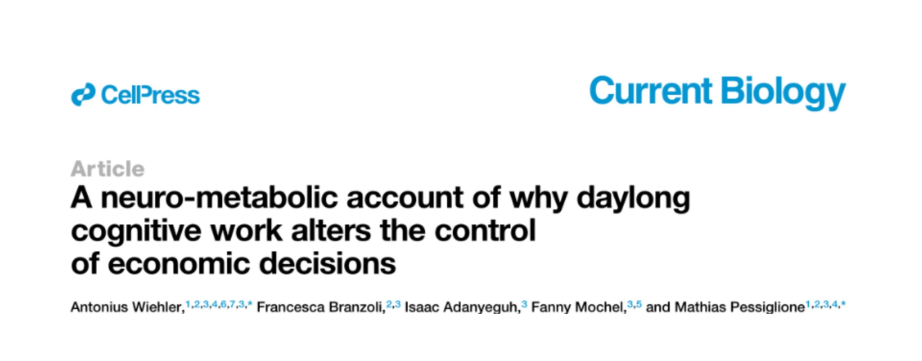
In order to elucidate the functional and biological mechanisms of cognitive fatigue, the researchers recruited 40 participants and divided them into simple groups (n=16) according to the difficulty of participating in cognitive tasks. ) and the difficult group (n=24).
To induce cognitive fatigue, all participants were required to perform two cognitive control tasks (N-switch and N-back) within 6.25 hours. The N-switch task requires participants to complete the distinction between vowels and consonants or uppercase and lowercase according to the color of the letters. The difficulty of this task depends on the speed of the letter color change; the N-back task requires participants to state whether the letters on the screen are different from those before. The letters presented across trials were identical, and the difficulty of the task depended on the time interval between trials.
Then, the researchers asked both groups of participants to make four economic decisions, with each choice designed as a small reward/low cost (LC ) or Big Reward/High Cost (HC) mode. For example, the LC model means that participants can receive 41.20 euros immediately, while the HC model means that participants will receive 50 euros after one month. The cognitive tasks and economic decision-making of participants in the two groups were alternated for 5 cycles.
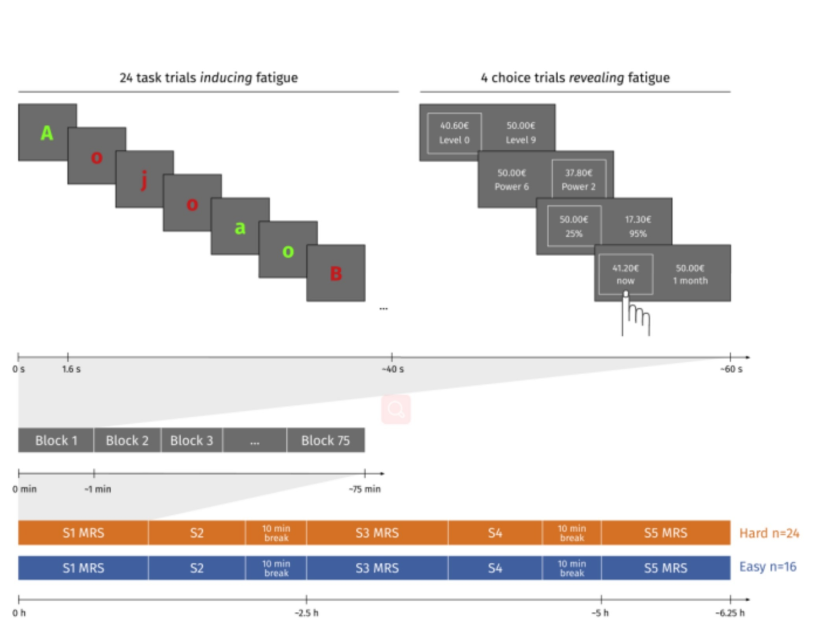
Experimental design pattern diagram
The researchers then analyzed the participants’ objective performance and subjective ratings to assess the cognition of the two groups of participants Level of fatigue. The results showed that participants in both groups scored similarly over time. It is speculated that people generally fail to subjectively report fatigue related to task difficulty, that is, the degree of cognitive control load.
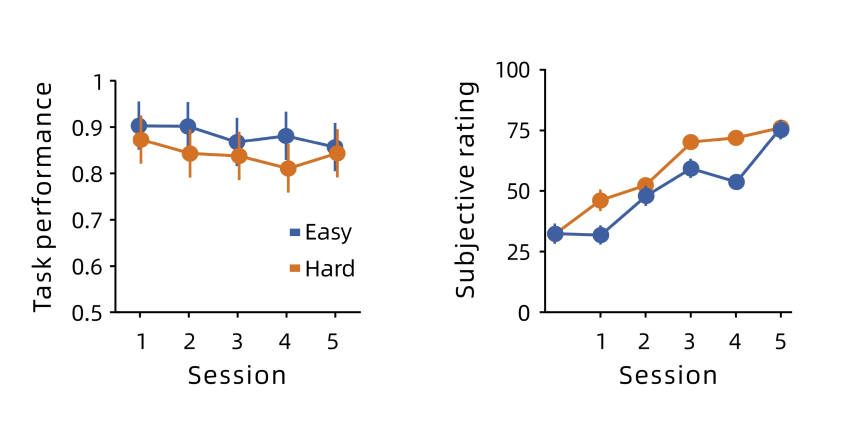
The average accuracy and subjective fatigue scores of the two groups of participants in cognitive tasks (0 means very good, 100 means exhausted)
Despite this, by analyzing the economic decision-making behavior of the two groups of participants, the researchers found that participants in the difficult group were more inclined to the LC mode in economic decision-making, thus speculating that cognitive fatigue may cause This results in people tending to choose options with low cognitive control costs.
However, due to the lack of magnetic resonance scan data, it is currently impossible to verify whether this selection bias is related to reduced lPFC activity during selection.
There is no difficult research work, only brave researchers! After reviewing the literature, researchers found that pupil dilation is related to the level of energy required for cognitive control and can be used as an indicator to measure the cost of cognitive control in economic decision-making [2-3].
So they quickly changed their research ideas and measured the changes in pupil dilation of the participants in the two groups. The results showed that over time, the pupil dilation of the participants in the difficult group increased. There is a significant decrease, suggesting that when participants are in a state of cognitive fatigue, they invest less energy in decision-making considerations.
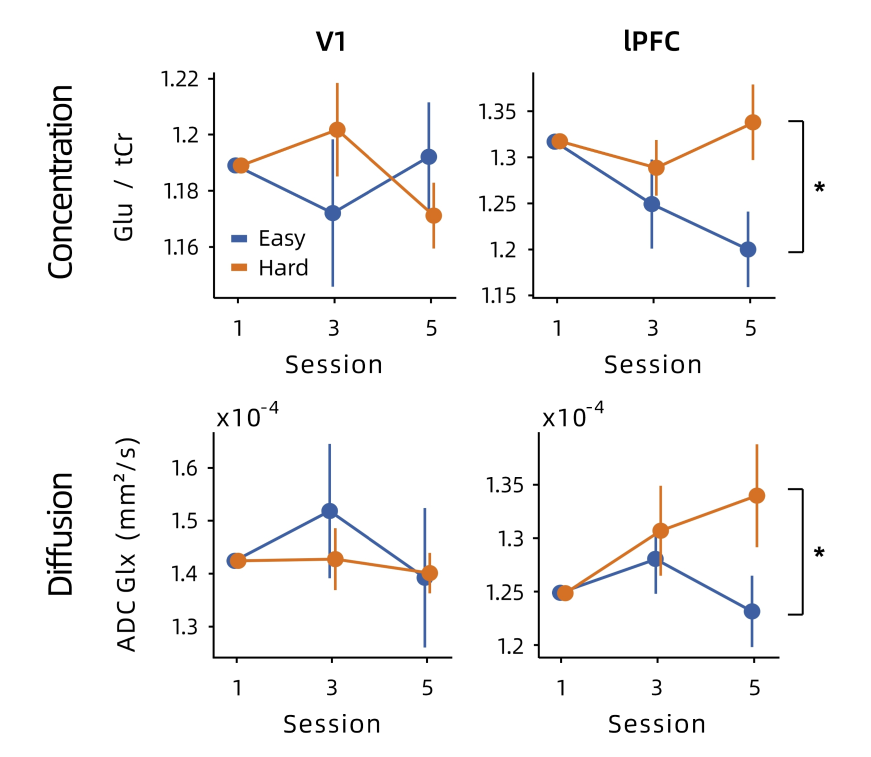
Pupillary dilation changes in two groups of participants during cognitive fatigue
After so much effort, I finally figured out the ins and outs of how cognitive fatigue affects decision-making. Highly difficult cognitive tasks will increase the cost of cognitive control and cause cognitive fatigue. At this time, our smart brains can easily enter the "fishing" state, so we are more inclined to choose options with short-term returns in decision-making behavior. .
Suddenly realized! It turns out that there is a scientific basis for spending money randomly after working hard all day! After all, as the commander-in-chief, how could he still resist when his brain is "tired" all day long? Carpe diem of course!
Getting back to the subject, why does the cost of cognitive control increase as the difficulty of the cognitive task increases? To explore the biological mechanism behind this, the researchers turned their focus to brain metabolism. They used magnetic resonance spectroscopy (MRS) to detect metabolite concentrations in the lPFC and primary visual cortex (V1) of the brains of the two groups of participants.
The results showed that glutamate was the only metabolite that showed a three-way interaction (cognitive task group, brain region, task execution time). Moreover, compared with the simple cognitive task group and V1 area, the glutamate concentration and the apparent diffusion coefficient level of glutamate and total glutamine (Glx) in the lPFC area of the brain of participants in the difficult cognitive task group were higher. high.

Top: Glutamate concentration normalized to total creatine in the lPFC and V1 areas of the brain of the two groups of participants
Bottom: The apparent diffusion coefficient of Glx glutamate and total glutamine in the lPFC area and V1 area of the brain of the two groups of participants
Finally, the researchers evaluated the correlation between economic decision-making behavior and brain metabolism in states of cognitive fatigue. The results showed that there was a positive correlation between the degree of decision-making tending to LC during cognitive fatigue and both glutamate concentration and increased Glx diffusion, but only the increase in Glx diffusion had a significant statistical difference, indicating that participants were in a state of cognitive fatigue. The DuChong LC option is related to the level of Glx diffusion, which is related to the accumulation of glutamate.
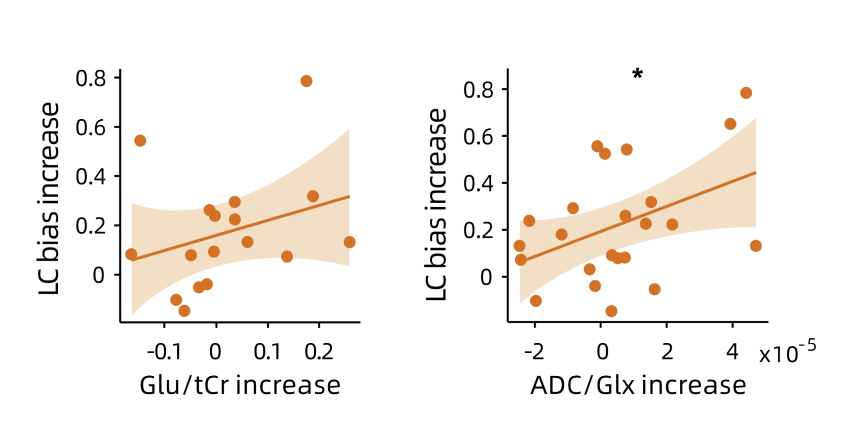
The relationship between participants’ decision-making behavior and glutamate concentration and diffusion levels Relevance
Overall, this study suggests A neurometabolic model to explain the mechanism of cognitive fatigue, that is, glutamate accumulation triggers a regulatory mechanism that makes the activation cost of lPFC higher, making it difficult to mobilize cognitive control after tiring work, so people's Decision-making behavior also favors simple and easy “low-cost” options.
However, it should be noted that the research results of the Pesiglione team only suggest cognitive fatigue Related to glutamate metabolism, rather than proving that preventing glutamate accumulation can improve cognitive control, the target that needs to be regulated may not be glutamate itself, but any substance related to glutamate accumulation.
In addition, the subjective reporting of fatigue levels in the study is particularly noteworthy. This suggests that there may be a discrepancy between actual fatigue in the brain's cognitive control system and our perception of fatigue. So, when you come out to work, don’t wait until your brain can’t move before you think of taking a break. Work for two hours and relax for two minutes, and you may be more efficient!
References:
1. Wiehler A, Branzoli F, Adanyeguh I, Mochel F, Pessiglione M. A neuro-metabolic account of why daylong cognitive work alters the control of economic decisions. Curr Biol. 2022;32(16):3564-3575.e5.
2. van der Wel P, van Steenbergen H. Pupil dilation as an index of effort in cognitive control tasks: A review. Psychon Bull Rev. 2018;25(6):2005-2015.
3. Borderies N, Bornert P, Gilardeau S, Bouret S. Pharmacological evidence for the implication of noradrenaline in effort. PLoS Biol. 2020;18(10):e3000793.